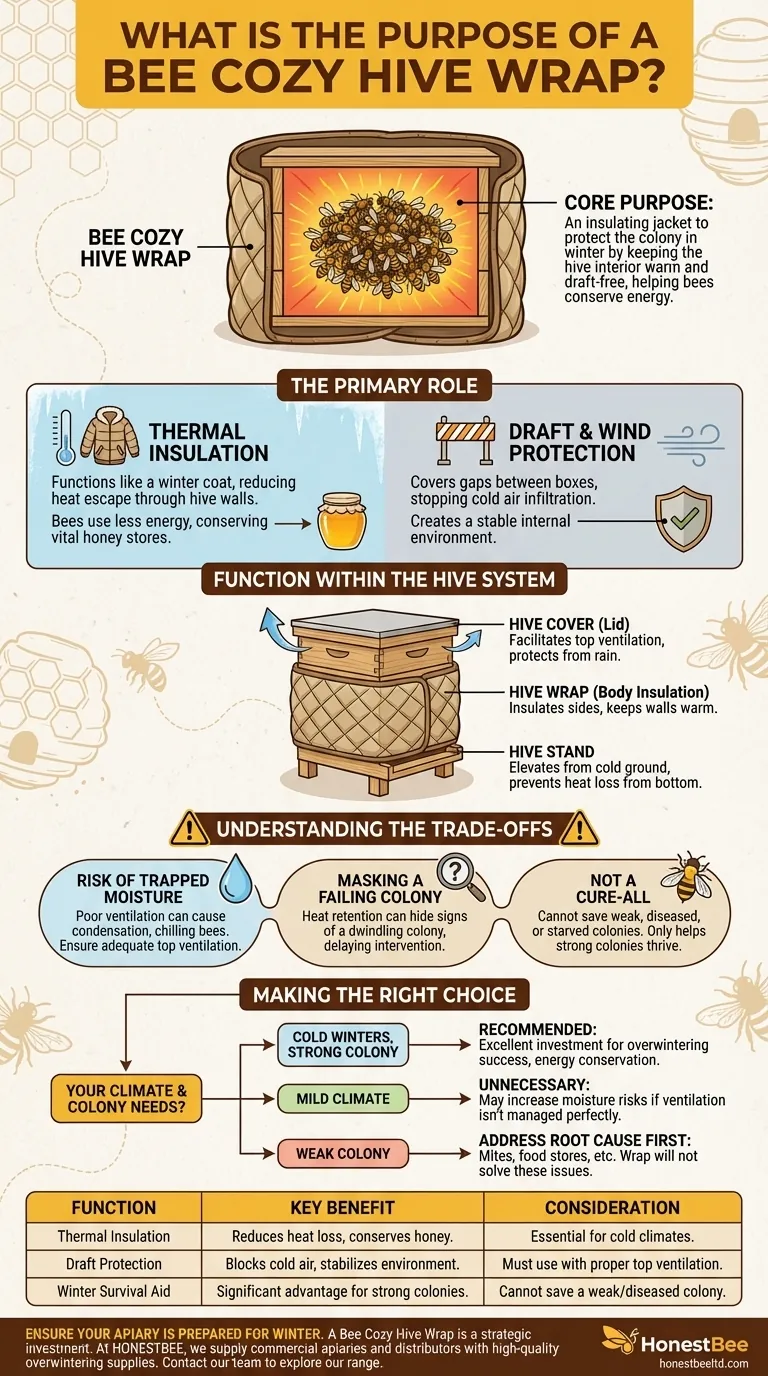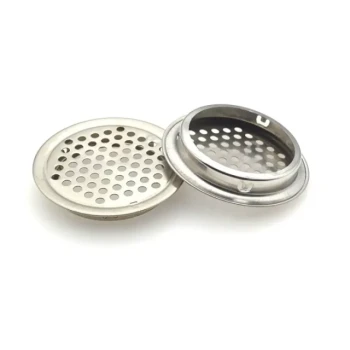At its core, a bee cozy hive wrap is an insulating jacket for your beehive. Its primary purpose is to protect the honeybee colony during winter by keeping the hive's interior warm and free from drafts, helping the bees conserve the energy they need to survive the cold months.
The central challenge for a bee colony in winter isn't just the cold, but the immense energy required to stay warm. A hive wrap doesn't generate heat; it enables the bees to use their own self-generated heat far more efficiently, reducing stress and the consumption of vital honey stores.

The Primary Role of a Hive Wrap
A hive wrap serves as a critical piece of overwintering equipment by modifying the hive's immediate environment. It directly addresses the two biggest threats posed by cold weather: heat loss and drafts.
Thermal Insulation
A bee cozy is made of thick, insulating material that functions much like a winter coat.
Honeybees form a tight cluster inside the hive during winter, vibrating their wing muscles to generate heat. The wrap significantly reduces how quickly this precious heat escapes through the wooden walls of the hive.
This efficiency means the colony burns through less of its winter honey supply, increasing its chances of having enough food to last until spring.
Draft and Wind Protection
Drafts can be more lethal to a colony than still, cold air.
A wrap slides over the entire hive, covering the small gaps between hive boxes that can allow cold air to infiltrate. This creates a more stable internal environment, protecting the cluster from sudden, life-threatening temperature drops.
How a Wrap Functions Within the Hive System
A hive wrap is a specialized tool that works in conjunction with other essential hive components. It is not a standalone solution for hive health.
Complementing the Hive Cover
The standard hive cover (or lid) provides protection from rain and sun while often facilitating top ventilation.
The wrap provides insulation for the hive body. These two components work together: the wrap keeps the walls warm, while the cover allows excess moisture from the bees' respiration to escape.
Supporting the Hive Stand
A hive stand elevates the entire structure off the cold, damp ground.
This protects the colony from heat loss through the bottom board and discourages pests. The hive wrap complements this by protecting the colony from heat loss through the sides, creating a complete protective envelope.
Understanding the Trade-offs
While highly effective, using a hive wrap is not without considerations. Misapplication can potentially create problems for the colony.
The Risk of Trapped Moisture
The most significant potential downside is trapping moisture. A well-insulated but poorly ventilated hive can lead to condensation on the cold inner cover.
This moisture can drip down onto the bees, chilling and even killing them. It is critical to ensure the hive has adequate top ventilation when using a wrap.
Masking a Failing Colony
A wrap can make it difficult to perform quick external assessments of a hive's status.
Because it helps retain heat so well, it can sometimes mask the signs of a dwindling or failing colony, preventing a beekeeper from intervening when there might still be time.
It Is Not a Cure-All
A hive wrap cannot save a weak colony. Hives that are small, diseased, or have insufficient food stores will likely perish with or without a wrap. Its purpose is to help an already strong and healthy colony thrive through winter.
Making the Right Choice for Your Apiary
Deciding whether to use a hive wrap depends entirely on your climate and the specific needs of your colonies.
- If your primary focus is surviving long, cold winters: A hive wrap is an excellent investment to improve overwintering success rates by helping your bees conserve energy.
- If your primary focus is managing hives in a mild climate: A wrap is likely unnecessary and may increase the risk of moisture-related problems if ventilation isn't managed perfectly.
- If your primary focus is saving a weak colony: Address the root cause first, such as mite load or food stores, as a wrap will not solve these fundamental issues.
Ultimately, a bee cozy is a strategic tool that empowers a well-prepared colony to face the harshest season with a significant advantage.
Summary Table:
| Function | Key Benefit | Consideration |
|---|---|---|
| Thermal Insulation | Reduces heat loss, helping bees conserve honey stores. | Essential for cold climates. |
| Draft Protection | Blocks cold air infiltration for a stable hive environment. | Must be used with proper top ventilation. |
| Winter Survival Aid | Gives a strong, healthy colony a significant advantage. | Cannot save a weak or diseased colony. |
Ensure your apiary is prepared for winter. A Bee Cozy Hive Wrap is a strategic investment in your colony's survival. At HONESTBEE, we supply commercial apiaries and beekeeping equipment distributors with the high-quality, wholesale supplies needed for successful overwintering.
Let us help you protect your investment. Contact our team today to discuss your hive management needs and explore our range of durable beekeeping equipment.
Visual Guide

Related Products
- Professional Insulated Winter Hive Wrap for Beekeeping
- Inner Beehive Cover for Beekeeping Bee Hive Inner Cover
- Professional Insulated Plastic Bee Hives
- Telescopic Beehive Outer Cover Lid Roof with Galvanised Sheeting for Langstroth Hive and Beehive Outer Cover
- Wholesales Dadant Size Wooden Bee Hives for Beekeeping
People Also Ask
- Why is insulation important for hives during winter? Ensure Your Bees Survive and Thrive
- What is the advantage of an insulated outer cover? Boost Winter Survival & Spring Buildup
- What factors ensure bees stay warm and healthy during winter? Master the 3 Keys to Hive Survival
- Why is it important to insulate beehives during winter? Boost Your Colony's Survival Rate
- How does insulation help bee hives in severely cold weather? Conserve Energy & Ensure Colony Survival



















